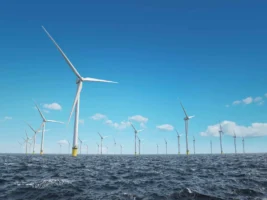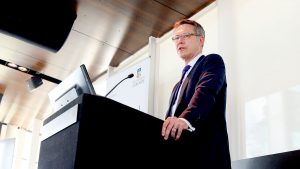The Coalition government may think that electric vehicles may signal the end of the traditional Aussie weekend, but the country’s biggest mining group BHP sees it as the future of its mining business.
And just as the Coalition government ramps up its efforts to push through the Adani coal mine, and potentially new investments in coal generation, BHP has declared that thermal coal is likely to make a quicker exit than most people expect, and it is getting ready for a decarbonised economy.
BHP’s landmark strategy briefing, delivered by CEO Peter Beaven to analysts on Wednesday, highlights the growing gulf between what individual companies see as the future of renewables and electric vehicles, and the self-interested rhetoric of the business lobbies that represent them and the Coalition government that slavishly adheres to conservative nay-sayers.
In the briefing, Beaven made it clear that the company’s future will depend on its ability to supply the resources that will be needed for a decarbonised economy, which happily coincide with a lot of minerals that it mines – copper, nickel and others.
 It also took note of its so-called ‘licence to operate’, acknowledging that the mining giant’s operations exist within wider social and political trends, not to mention the scientific consensus which screams at the need to adhere to the Paris climate goals of limiting average global warming to around 1.5°C.
It also took note of its so-called ‘licence to operate’, acknowledging that the mining giant’s operations exist within wider social and political trends, not to mention the scientific consensus which screams at the need to adhere to the Paris climate goals of limiting average global warming to around 1.5°C.
BHP recognised the core areas that it needs to address to ensure its future operations, including the decarbonisation of electricity generation, the electrification of transport, the need for biodiversity conservation and greater obligations to be part of a circular economy.
It even cited the recent UN report warning of massive biodiversity loss, something that the Coalition government all but ignored.
“(There is an) accelerated social and political push to achieve zero emissions from stationary power to contain global warming to well below 2 degrees.” it noted.
“Electric Vehicles (EVs) (will) progressively displace the internal combustion engine (ICE) as cost, range and charging constraints are overcome.”
BHP also produced this graph (immediately above), which must have been prepared on the assumption that Labor would win the election. It contains hopes of pro-EV policies and early phase out of coal that the re-elected Coalition government has rejected, and it uses terms such as the “circular economy” that the Coalition would likely never heard of.
Interestingly, BHP is also planning to invest up to $1.2 billion automating its 500-strong haulage truck fleet in its mining operations in W.A. and Queensland, and expects this to become progressively electric as “heavy duty EVs” become more competitive.
It sees a roll-out of this technology from 2020-2023, depending on individual asset operations, following in the example of Fortescue Metals and others.
BHP says it cannot see a case for new thermal coal investments, noting there is “no appetite” for such investments, and it also warns that gas is likely to be leapfrogged by renewables, particularly in developing countries, and the long pay-back for LNG projects carries significant risks.
 But BHP does see the shift towards renewable energy as a positive opportunity for some of the core parts of its business. The use of copper in power generation, and the use of nickel in electric vehicle production present future growth opportunities for these resources, and BHP will continue to invest in their production capacity for these resources.
But BHP does see the shift towards renewable energy as a positive opportunity for some of the core parts of its business. The use of copper in power generation, and the use of nickel in electric vehicle production present future growth opportunities for these resources, and BHP will continue to invest in their production capacity for these resources.
Notably, BHP sees limited new opportunities for lithium production. While recognising that significant growth in demand for lithium as a result of the explosion in battery demand, BHP sees the market for lithium as already well supplied, and the attractiveness of moving into this market as being low.
BHP is preparing for the phase out of its energy (thermal) coal business, with the potential of such a phase out happening faster than expected and that there is “no appetite for growth in energy coal regardless of asset attractiveness.”
“Hydrocarbons demand is expected to be tempered by increased renewables in the energy mix,” Beaven said. “Thermal coal should remain a large market – but over time we expect it to plateau and then decline, as headwinds strengthen.“
But BHP stopped short of saying that it would divest itself of its remaining thermal coal assets, and sees ongoing benefits in remaining in the market for metallurgical coal, particularly through supplies to its own steel production facilities.
“Our energy coal exposure is just 3 per cent of our asset base. But it is made up of two very high quality mines which generate high margins. Our focus will be on maximising value to shareholders, whether we are long term owners or not.” Beaven said.
BHP’s main competitor, Rio Tinto, has recently completed a process of divesting itself of all thermal coal assets.
The shift away from expanding the thermal coal assets of both BHP and Rio Tinto is a contrast to the accelerated moves to approve the Adani Carmichael Coal mine following the federal election.
The Queensland Labor Government has used the Federal election result as the impetus to ensure new coal projects get off the ground, in an attempt to reengage with a blue-collar workforce that has shifted away from Labor.
“The Federal election was a big wake up call for everyone, not just in Queensland, but right across the country.” Fundamentally, Labor needs to get back to its values, and it needs to get back to its grassroots.” Queensland premier Annastacia Palaszczuk told reporters in Townsville.
But with Australia’s two largest resources companies moving away from the business of thermal coal, and news that a mine neighbouring that of the Adani Carmichael mine looks to be falling over, Palaszczuk may find it difficult to deliver new jobs to regional Queensland without a plan that extends beyond coal.











